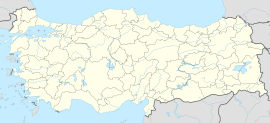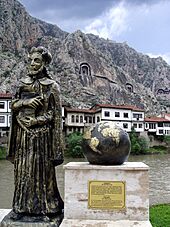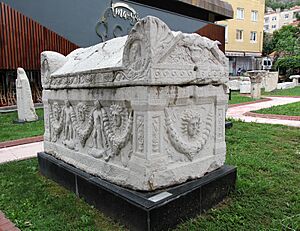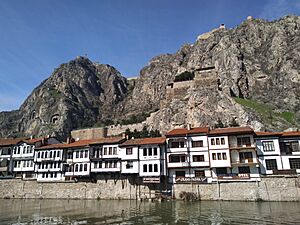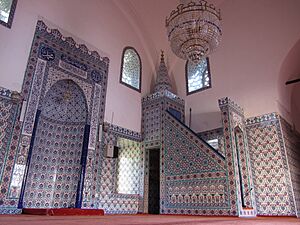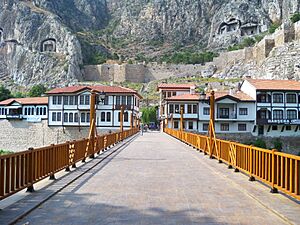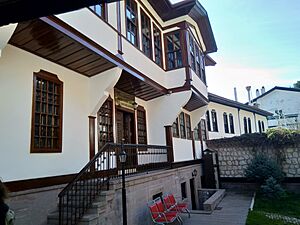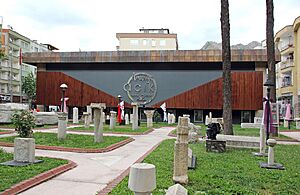Amasya facts for kids
Quick facts for kids
Amasya
|
|
|---|---|
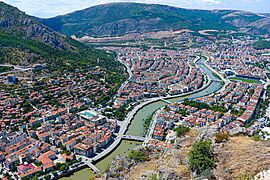
A partial view of Amasya seen from Amasya Castle.
|
|
| Country | Turkey |
| Province | Amasya |
| District | Amasya |
| Population
(2021)
|
114,921 |
| Time zone | TRT (UTC+3) |
Amasya (pronounced a-MAS-ya) is a city in northern Turkey, located in the Black Sea Region. In ancient times, it was known as Amaseia or Amasia. It is the main city of Amasya Province and Amasya District, with a population of 114,921 people as of 2021.
Amasya is nestled in a narrow valley along the Yeşilırmak River, surrounded by mountains. Even though it's near the Black Sea, the city's high elevation gives it an inland climate. This climate is perfect for growing apples, which Amasya province is famous for!
The city has a very long history, going back 7,500 years. Many signs of its past are still visible today. Amasya was once home to the famous geographer Strabo and was the birthplace of the 15th-century Armenian scholar and doctor Amirdovlat Amasiatsi.
In ancient times, Amaseia was a strong, fortified city built high on cliffs above the river. It was a rich capital that produced kings, princes, artists, scientists, poets, and thinkers. This includes the kings of Pontus and many generations of the Ottoman royal family. Amasya is popular with visitors because of its traditional Ottoman wooden houses and the impressive tombs of the Pontus kings carved into the cliffs. In recent years, a lot of money has been invested in making the city even better for tourists.
During the early Ottoman period, young Ottoman princes often came to Amasya to learn how to govern. Two Ottoman sultans, Murad I and Selim I, were born here. Many old Ottoman houses near the Yeşilırmak River have been restored. These traditional Yalıboyu houses are now used as cafes, restaurants, and hotels. Behind them, you can still see the ancient rock tombs of the Pontic kings.
Contents
Etymology

The name Ἀμάσεια (Amaseia) comes from Amasis, a queen of the Amazons. According to the ancient writer Strabo, the Amazons were said to have lived here. The name of the city has stayed very similar throughout history. In Greek, it was Ἀμάσεια, Amaseia, Amassia, and Amasia. In Armenian, it's Ամասիա, and in Ottoman Turkish and modern Turkish, it's Amasya. All these names sound very much alike.
History
Ancient Times
Archaeological studies show that Amasya was first settled by the Hittites. After them, different groups lived here, including the Phrygians, Cimmerians, Lydians, Greeks, Persians, and Armenians.
Hellenistic Period
An independent kingdom called Pontus was formed in the late 4th century BC. Its capital was Amaseia. This happened after Alexander's conquests. By 183 BC, Greeks had settled in the city. It became the capital of the Kingdom of Pontus from 333 BC to 26 BC. Today, you can still see the impressive royal tombs of Pontus carved into the rocks above the river in the city center.
Roman-Byzantine Period
The Romans captured Amaseia in 70 BC. It quickly became a free city and an important administrative center. The famous geographer Strabo described Amaseia as a busy city with many thinkers, writers, and poets around 60 BC to 19 AD.
Later, the city became part of the Roman province of Galatia. Around 112 AD, Emperor Trajan made it part of the province of Cappadocia. In the 2nd century, it was given the important titles of 'metropolis' (a major city) and 'first city'. When the Roman Empire split, Amaseia became part of the East Roman Empire (the Byzantine Empire). At this time, most of its people spoke Greek.
The city was also mentioned in the book Alexiad. This book tells how Emperor Alexios I Komnenos received a Norman general named Ursel as a prisoner in Amaseia. Ursel had been causing trouble in the Byzantine Empire. Alexios convinced a Turkic general to capture him.
Important Christian figures from this time include Saints Theodore of Amasea (who died around 319 AD) and Bishop Asterius of Amasea (who died around 410 AD).
In 2013, a 24-square-meter Christian mosaic was found. It was part of a chapel floor and shows apples, an apple tree, partridges, and many geometric shapes.
Early Turkish Rulers
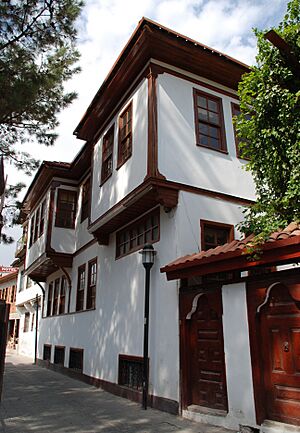
In 1075, after 700 years of Byzantine rule, Amasya was taken over by the Turkmen Danishmend leaders. It became their capital. Later, the city came under the control of the Seljuk rulers.
During the 13th century, the city was ruled by the Mongols. Under the Seljuks and Mongols, Amasya became a center for Islamic culture. Many schools, mosques, tombs, and other buildings from this period still stand today.
In 1391/92, the Ottoman sultan Bayezid I took control of Amasya. He made his son, the future Mehmed I, its governor.
Ottoman Era
After a big battle in 1402, Mehmed I came to Amasya. The city became his main home and a strong base during a difficult time for the Ottoman Empire.
Because of this, Amasya had a special role under the Ottomans. Many Ottoman princes were sent to Amasya as governors when they were young. This helped them gain experience for their future roles as sultans. This tradition continued from the late 14th century with Mehmed II, to Bayezid II in the 15th century, and Murat III in the 16th century.
Suleiman the Magnificent, a famous Ottoman sultan, often stayed in Amasya. The city became one of the most important places for learning in Anatolia.
In 1555, the Peace of Amasya was signed here. This was an important agreement with the Safavid dynasty of Persia.
The people of Amasya during the Ottoman era were very diverse. This was part of the princes' training to learn about all the different groups in the Empire. Every major group in the Empire had a village in Amasya, like a Greek village, an Armenian village, a Turkish village, and so on.
In the late 1800s, Amasya had about 25,000 to 30,000 people. Most were Turks, but there were also Armenians and Greeks.
World War I and the Turkish War of Independence
In 1919, Amasya was where Mustafa Kemal Atatürk held important meetings. He planned to build a Turkish army and create the Turkish republic after the Ottoman Empire ended. It was here that Atatürk announced the Turkish War of Independence in the Amasya Circular. This document is seen as the start of the war. The circular said that Turkey's independence was in danger. It called for national meetings to be held in Sivas and Erzurum.
During World War I and the Turkish War of Independence, the Christian people of Amasya faced difficult times. Many Armenian civilians sought safety at an American missionary school. In 1921, Turkish troops closed the school. Later, many people moved to Thessaloniki as part of a population exchange.
Ecclesiastical History
Amasea became an important center for Christian bishops in the Eastern Roman Empire starting in the 3rd century AD. It was the main archbishopric for its region. Over time, the number of Christians decreased due to Turkic migrations. The Orthodox Christian community in Amasea was active until the Population exchange between Greece and Turkey in 1923. In 1922, there were about 40,000 Christians, with 20,000 of them speaking Greek.
Today, Amasea is no longer a residential diocese. It is listed by both the Eastern Orthodox Church and the Catholic Church as a titular see, which means it's a historical title.
The Legend of Ferhat and Shirin
This classic folk tale is said to have happened in Amasya. The nearby mountain Ferhat is named after Ferhat, the hero of the story. He was deeply in love with Princess Shirin. To win her father's approval, Ferhat tried to dig a tunnel through the mountain to bring spring water to the palace. Sadly, while he was working, he was tricked into believing Shirin had died. In his sorrow, he threw himself onto the rocks. His beloved princess died soon after. This story has been made into a play, a novel, and an opera.
Climate
Amasya has a climate that is a mix of a hot-summer Mediterranean climate and a hot summer oceanic climate.
It is warmer than central Anatolia, and its winters are not as cold.
- Highest recorded temperature: 45.0 °C (113.0 °F) on July 30, 2000
- Lowest recorded temperature: -21.0 °C (-5.8 °F) on January 15, 2008
| Climate data for Amasya (1991–2020, extremes 1961–2022) (Elevation: 409, coordinates: 40°40′0″N 35°50′7″E / 40.66667°N 35.83528°E) | |||||||||||||
|---|---|---|---|---|---|---|---|---|---|---|---|---|---|
| Month | Jan | Feb | Mar | Apr | May | Jun | Jul | Aug | Sep | Oct | Nov | Dec | Year |
| Record high °C (°F) | 23.5 (74.3) |
24.8 (76.6) |
31.2 (88.2) |
35.8 (96.4) |
37.9 (100.2) |
41.8 (107.2) |
45.0 (113.0) |
42.2 (108.0) |
43.5 (110.3) |
36.0 (96.8) |
29.7 (85.5) |
22.9 (73.2) |
45.0 (113.0) |
| Mean daily maximum °C (°F) | 7.4 (45.3) |
10.2 (50.4) |
15.0 (59.0) |
20.6 (69.1) |
25.6 (78.1) |
29.3 (84.7) |
31.9 (89.4) |
32.3 (90.1) |
28.6 (83.5) |
22.7 (72.9) |
14.6 (58.3) |
8.9 (48.0) |
20.6 (69.1) |
| Daily mean °C (°F) | 2.8 (37.0) |
4.6 (40.3) |
8.5 (47.3) |
13.3 (55.9) |
17.8 (64.0) |
21.6 (70.9) |
24.2 (75.6) |
24.4 (75.9) |
20.5 (68.9) |
15.2 (59.4) |
8.2 (46.8) |
4.4 (39.9) |
13.8 (56.8) |
| Mean daily minimum °C (°F) | −0.7 (30.7) |
0.2 (32.4) |
3.3 (37.9) |
6.9 (44.4) |
11.1 (52.0) |
14.7 (58.5) |
17.0 (62.6) |
17.3 (63.1) |
13.4 (56.1) |
9.2 (48.6) |
3.3 (37.9) |
1.1 (34.0) |
8.1 (46.6) |
| Record low °C (°F) | −21.0 (−5.8) |
−20.4 (−4.7) |
−15.3 (4.5) |
−5.1 (22.8) |
−0.1 (31.8) |
4.8 (40.6) |
8.5 (47.3) |
8.8 (47.8) |
3.0 (37.4) |
−2.9 (26.8) |
−9.5 (14.9) |
−12.7 (9.1) |
−21.0 (−5.8) |
| Average precipitation mm (inches) | 46.2 (1.82) |
36.7 (1.44) |
50.2 (1.98) |
51.9 (2.04) |
61.3 (2.41) |
41.0 (1.61) |
12.9 (0.51) |
12.9 (0.51) |
21.3 (0.84) |
36.4 (1.43) |
44.6 (1.76) |
53.8 (2.12) |
469.2 (18.47) |
| Average precipitation days | 11.77 | 11.07 | 12.53 | 12.8 | 12.9 | 9.17 | 3.2 | 2.67 | 5.1 | 8.47 | 8.20 | 12.43 | 110.3 |
| Average snowy days | 5.17 | 2.45 | 2 | 0.27 | 0 | 0 | 0 | 0 | 0 | 0 | 0 | 2.09 | 11.98 |
| Average relative humidity (%) | 68.4 | 62.2 | 57.4 | 54.4 | 54.9 | 53.3 | 50.7 | 51.6 | 54.3 | 60.7 | 66.5 | 70.2 | 58.7 |
| Mean monthly sunshine hours | 68.2 | 93.2 | 136.4 | 180.0 | 229.4 | 261.0 | 297.6 | 282.1 | 222.0 | 155.0 | 105.0 | 62.0 | 2,091.9 |
| Mean daily sunshine hours | 2.2 | 3.3 | 4.4 | 6.0 | 7.4 | 8.7 | 9.6 | 9.1 | 7.4 | 5.0 | 3.5 | 2.0 | 5.7 |
| Source 1: Turkish State Meteorological Service | |||||||||||||
| Source 2: NOAA NCEI(humidity), Meteomanz(snowy days 2013-2023) | |||||||||||||
Amasya Today
Amasya province is famous for its small, tasty apples. The city itself isn't a huge industrial center, but it's very charming and well-preserved. It's especially beautiful by the river on a foggy winter evening. Tourists and soldiers from the local base help the local shops. A railway line from Sivas to Samsun passes through Amasya, and it has a lovely Ottoman-era railway station.
Amasya has some nightlife, mostly bars and cafes for visitors, and simple restaurants. It's not a very strict city, unlike some other cities in central and eastern Anatolia. Social life becomes more lively in the summer, partly due to tourism. Many international circus groups visit the city. June 12 is a special festival date for Amasya, with lots of cultural and sports events.
Local foods include toyga çorbası, a soup made with yogurt that can be eaten hot or cold. Other local treats are pastries with poppy seeds and tea, often enjoyed by the river.
An airport in the district opened for civilian flights in 2008. Before that, it was only for military use. There are daily one-hour flights to and from Istanbul.
Tourism in Amasya
Tourism in Amasya has been growing a lot. In 2011, there were 500,000 tourists, and 11,000 of them were from other countries. By 2013, the total number reached 750,000. Many new hotels, especially small, unique "boutique" hotels, are opening. Many old Ottoman wooden houses have been restored and are now used as boutique hotels, cafes, and bars.
The ruins of the Amasya Castle hold 2000-year-old water channels, 1000-year-old bridges, a hospital, a palace, and a secret underground passage. The rock faces have ancient rock tombs that look amazing, especially at night when they are lit up.
The city also has many beautiful and historic buildings:
- The Ferhat water channel.
- The 13th-century Seljuk Burmali Mosque.
- The 15th-century Yildirim Beyazit Mosque and Complex.
- The 14th-century Ilhanli Bimarhane Mental Hospital, with lovely carvings around its entrance.
- The unique octagonal Kapi Aga Medrese (a religious school).
- The Torumtay Mausoleum and the Gök Medrese.
There are also traditional Turkish mansions that show great examples of Turkish architecture. The 19th-century Hazeranlar Mansion has been perfectly restored. It now has an art gallery on its first floor and a museum about local life on the second. The Archaeological Museum of Amasya has an interesting collection, including mummies of the Ilhanli rulers of Amasya.
- On the Harşena rock above the town are the royal palace ruins and the tombs of the kings of Pontus. These tombs are carved into the limestone rocks and are very impressive, especially when lit up at night. The famous geographer Strabon (63 BC - 5 AD), who was born in Amasya, wrote that these rock tombs belonged to the kings of Pontus.
- Aynalı Cave (Rock Tomb) is about three kilometers from the city center. It is the most decorated and complete tomb among the King Rock Tombs.
- Harsene Kalesi is an old fortification mentioned by Strabo. It was largely rebuilt in medieval times and now lies in ruins on a rocky hill above the town. Another castle, Enderun Kalesi, has some remains in the Nerkis district.
- The Saraydüzü Casern building was rebuilt in 2009. It is important because the Amasya Circular, which started the Turkish War of Independence, was signed there on June 12, 1919. Today, it is a war of liberation museum and a congress center.
- Many tombs of Muslim saints, called yatır, are believed to have healing powers.
- Ferhat Water Canal was built in the Hellenistic Period to bring water to the city. It is about 75 centimeters wide and 18 kilometers long.
- Lake Borabay (65 km northeast of Amasya) is a beautiful crater lake. It's a great place for fishing, picnics, and sports.
- Other places to visit near Amasya include Yedikir reservoir and Omarca National Park.
- Terziköy thermal spring is one of the most important hot springs in the province.
Economy
The valley structure of the region gives it a mild climate, which is great for growing many fruits. Most of the city's economy comes from farming and farm products like vegetables and fruits. Other economic activities include mining, textiles, and making cement. In recent years, the production of electrical machines, household tools, and agricultural machines has grown in the Merzifon district of Amasya.
Amasya's main farm products are apples, cherries, okra, onions, poppy seeds, lentils, beans, and peaches. Industries based on agriculture are also important, such as sugar, dairy products, eggs, sunflower oil, and flour. Amasya is the second city in Turkey for marble exports.
Amasya University was founded in 2006.
Amasya is on an international road connecting Europe and Iran. It also links the Samsun port to inland parts of the country. The Amasya-Merzifon airport opened in 2008. These developments have helped cultural tourism grow. Amasya is a starting point for Black Sea tours and is also part of Cappadocia tours. The Ministry of Culture and Tourism has named Amasya one of 15 "trademark cities" in the country.
Cuisine
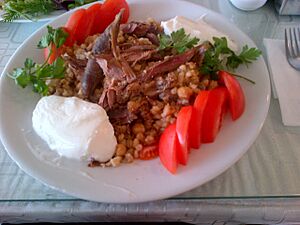
Amasya has been an important city for many civilizations and a training ground for future Ottoman sultans. Because of this, it has developed a special cuisine with unique tastes and qualities. One local dish is keşkek, which has always been very popular. Bakla dolması (stuffed vegetables with meat and broad beans) is another special local food.
Cream cakes were also a favorite in the old palace kitchens. Local breads include cherry bread. There's also a dessert called Unutma Beni (meaning "Forget me not"), made from slices of old bread.
Notable Natives
- Amirdovlat of Amasia, 15th century Armenian doctor and writer
- Mahmut Demir, world, Olympic, and European champion wrestler
- Serkan Erdoğan, basketball player
- Hamit Kaplan, world and Olympic champion wrestler
- Adem Ören, basketball player
- Merzifonlu Kara Mustafa Paşa, an Ottoman military leader and grand vizier
- Amasyalı Bayezid Pasha, Grand Vizier of the Ottoman Empire
- Yavuz Sultan Selim (I.Selim), Ottoman Sultan
- Sabuncuoglu Serafeddin, 15th century, Turkish doctor and surgeon
- Strabo, ancient geographer and historian (died in 23 AD)
- St. Theodore Teron, Christian Saint (died in 306 AD)
- Léon Arthur Tutundjian, Armenian painter
Geography
Amasya is located in a beautiful, narrow river valley. It's surrounded by steep cliffs and the high peaks of the Canik and Pontus mountains. The city is situated between the Black Sea and inner Anatolia, in a fertile area watered by the Tersakan, Çekerek, and Yeşilırmak rivers. Even though it's in the mountains, it's not far above sea level, which gives it a milder climate.
Five bridges cross the river, and most of the town is on the southern bank, stretching along the river. The climb up the valley walls is very steep, making them almost impossible to live on. The town is shaped like the letter 'v' because it follows a sharp bend in the river.
Quarters
Amasya has 37 different neighborhoods, called quarters:
- Akbilek
- Bahçeleriçi
- Beyazitpaşa
- Boğazköy
- Çakallar
- Demetevler
- Dere
- Ellibeşevler
- Fethiye
- Fındıklı
- Gökmedrese
- Göllübağlar
- Gümüşlü
- Haciilyas
- Hacilar Meydani
- Hatuniye
- Helvaci
- Hizirpaşa
- Ihsaniye
- Karasenir
- Kirazlidere
- Koza
- Kurşunlu
- Mehmetpaşa
- Nergiz
- Ormanbağlari
- Pirinçci
- Şamlar
- Şehirüstü
- Sevadiye
- Şeyhcui
- Sofular
- Üçler
- Yazibağlari
- Yeniköy
- Yeşilyenice
- Yüzevler
Twin Cities
Amasya has "twin city" relationships with several other cities around the world:
 Berat, Albania
Berat, Albania Brindisi, Italy
Brindisi, Italy Bursa, Turkey
Bursa, Turkey Lecce, Italy
Lecce, Italy Manisa, Turkey
Manisa, Turkey Osh, Kyrgyzstan
Osh, Kyrgyzstan Prizren, Kosovo
Prizren, Kosovo Sapporo, Japan
Sapporo, Japan Shamakhi, Azerbaijan
Shamakhi, Azerbaijan Solingen, Germany
Solingen, Germany Tulcea, Romania
Tulcea, Romania
Images for kids
-
Ancient Pontic tombs on the mountain
-
An example of an Ottoman architecture in Amasya
-
Medrese in Amasya, it is a form of Islamic school in Ottoman Empire
-
Keşkek was confirmed to be an Intangible Cultural Heritage of Turkey by UNESCO
See also
 In Spanish: Amasya para niños
In Spanish: Amasya para niños


